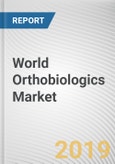The key factors driving the growth of the global orthobiologics market are increase in road accidents & sports injuries, rise in obesity rate, awareness among patients & athletes, and rapidly aging population. However, high cost of procedures, stringent regulatory approval procedures for each of the orthobiologic products, and lack of reliable clinical trial data are factors restraining the growth of this market. Advancements in implant technologies and growing demand of biological solutions as compared to mechanical solution create opportunities for its growth.
The global orthobiologics market is segmented based on product, end user, and geography. The market is further classified based on product into bone allograft, stem cell therapy, bone graft substitutes, bone growth factors & spinal stimulation, and viscosupplementation. On the basis of end user, the market is further categorized into hospitals, orthopedic clinics, and others. The market segmented geographically into North America, Europe, Asia, and Rest of the World (RoW).
The key manufacturers profiled in the report are Biomet Inc., Stryker Corporation, Medtronic PLC., Integra Life Sciences Corporation, Zimmer Inc., DePuy Synthes, Exactech Inc., Tornier Inc., Globus Medical Inc., Nuvasive Inc., and Wright Medical Technology Inc. The manufacturers implement strategies, such as agreements, partnerships, mergers & acquisitions, and others to gain the prominence in the market.
KEY BENEFITS FOR STAKEHOLDERS:
The report offers an in-depth analysis of current and future market trend of the global orthobiologics market.
The report provides a detailed analysis of key driving and restraining factors of the global orthobiologics market.
This report offers an extensive quantitative analysis of the current market and estimations through 2015-2020, which assists in identifying the prevailing market opportunities.
An in-depth analysis of dominant market shares for each segment helps in understanding the current market trend.
Geographically, the orthobiologics market is segmented into North America, Europe, Asia, and Rest of the World (RoW).
The key manufacturers within the global orthobiologics market are profiled in the report.
SWOT analysis highlights the internal environment of the key manufacturers for effective strategy formulation.
KEY MARKET SEGMENTS:
By Product
Bone Allograft
Stem Cell Therapy
Bone Graft Substitutes
Bone Growth Factors & Spinal Stimulation
Viscosupplementation
By End User
Hospitals
Orthopedic Clinics
Other End Users
By Geography
North America
Europe
Asia
Rest of the World (RoW)
Methodology
The analyst offers exhaustive research and analysis based on a wide variety of factual inputs, which largely include interviews with industry participants, reliable statistics, and regional intelligence. The in-house industry experts play an instrumental role in designing analytic tools and models, tailored to the requirements of a particular industry segment. The primary research efforts include reaching out participants through mail, tele-conversations, referrals, professional networks, and face-to-face interactions.
They are also in professional corporate relations with various companies that allow them greater flexibility for reaching out to industry participants and commentators for interviews and discussions.
They also refer to a broad array of industry sources for their secondary research, which typically include; however, not limited to:
- Company SEC filings, annual reports, company websites, broker & financial reports, and investor presentations for competitive scenario and shape of the industry
- Scientific and technical writings for product information and related preemptions
- Regional government and statistical databases for macro analysis
- Authentic news articles and other related releases for market evaluation
- Internal and external proprietary databases, key market indicators, and relevant press releases for market estimates and forecast
Furthermore, the accuracy of the data will be analyzed and validated by conducting additional primaries with various industry experts and KOLs. They also provide robust post-sales support to clients.

LOADING...








